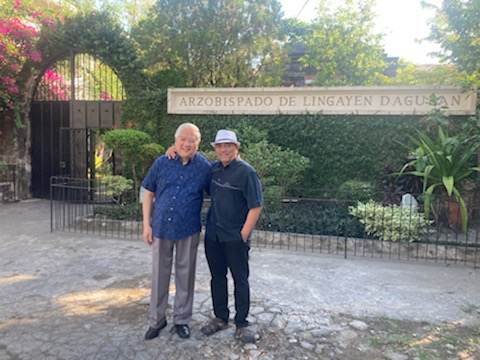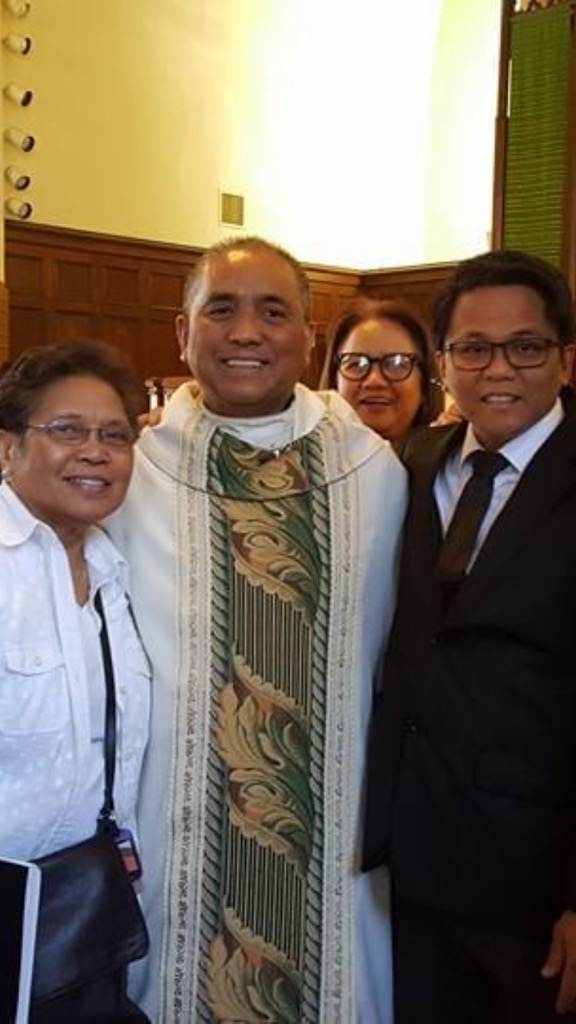“God chooses his servants well,” a parishioner said. Was she talking about looks? Smarts? Some have advanced degrees, while others speak multiple languages.

I was part of the Immaculate Heart of Mary Church (IHMC), a multicultural and trilingual parish in 2008, welcomed by Fr. Rodel Balagtas. Standing as one, in various colors and shades of our attires, we exchanged peace signs, one in “heart” for God, where Fr. Rodel Balagtas was its pastor for 12 years.
Some are effective with diverse cultures who worship, not segregated, but together as one — in worship, listening, praying, and singing in three languages: English, Tagalog, and Spanish.
100-year-old Church
IHMC was once a towering Gothic church supported by the Hollywood movie industry. It grew in the 20th century, and along with it, other poor churches that it helped. With donated land from Margaret Sullivan and $800 in funds raised, IHMC held its first Mass on Dec. 22, 1911, officiated by Rev. Daniel Murphy, for 300 people.
It expanded to 700 parishioners, a cornerstone was laid in 1940, and a new rectory was in 1948. From the 1950s to the 1960s, the Church grew and even donated $538,000 to poor parishes in its heyday.
Fast forward to 2008, located in the poor section of Hollywood (the east side), the Church had half-painted interior walls. Electrical wires dangled loosely from the side of the altar walls. Tattered pews had half-torn fabric kneelers. The once deep-blue carpet was heavily stained and turned gray.
Yet, despite being in a poor neighborhood, the bones of caring humanity could be felt. This community had a bakery, a small carinderia, a produce market, and a restaurant.
Fr. Balagtas took over this parish with a history of grievances from factions within. Dogma solidified their grievances. The community’s unhealthy condition mirrored the church structures — dying and falling apart.
Then, a transformation happened. The parish was mobilized for a centennial celebration. Archives were dug up, and new inspiration emerged from a realization that this church was built during the recession. After an economic slowdown in 2009-2011, the church was renovated.
The history inspired the community to reach its capital campaign goal, grossing over $1 million. On May 31, 2014, a wall permanently displayed the families who made donations of $1,000+, and with those: a repaired roof, painted interiors and exteriors, paved parking lots, an air-conditioning/heating system, a new electrical system for the church, new marble floors from the aisles to the altar, new baptismal font, new altar seats for the priests, (donated by Fr. Balagtas for the community), new trees in the school playground, a new auditorium floor, a new school roof and a new rectory kitchen floor from the leftover tiles. 3,000 came to celebrate its centennial.
In 2013, Fr. Balagtas trained Josh Diener, a seminarian at St. John’s. He is now a new priest with a Master’s in two specialties.
75-year-old St. John’s Seminary
From IHMC, a one-hundred-year-old church, Fr. Rodel’s journey took him to St. John’s Seminary in Camarillo, 100 miles one-way commute, where he is the Director of Pastoral Formation and Field Formation and faculty to seminarians.

In commemoration of its 75th anniversary, St. John’s Seminary commissioned five-time NY Times’ best-selling author Joe Garner to create a fully illustrated hardcover compendium of its history, entitled “I Will Give You Shepherds: The Story of St. John’s Seminary.”
Then deacon Josh Diener gave us a tour, “Land came from Don Camarillo, while the poor folk’s donated penny by penny to get the chapel finished. The rich folks, like Countess Carrie Estelle Doheny and Edward Laurence Doheny, built two libraries to house their collections of artifacts and books. Later, the libraries and their collections were donated to the seminary. The Doheny Collection included rare books, including Guttenberg Bible (a page on display from 1450-1455), which was sold to seed the initial endowment seminary fund.”
In this seminary, Fr. Balagtas obtained his Master of Arts in Religious Education, his thesis on “Evangelization of Cultures.” He has a doctorate in Ministry in Preaching at Aquinas Institute of Theology in St. Louis, Missouri, with a dissertation on “Communal Preaching for Transformation: Insights from a Filipino-American Community.”
Our interview with him took us to the Feast of Santo Niño, joined by parishioners at churches he served St. Augustine, St. Martha, St. Joseph the Worker, St. John Neumann, and Immaculate Heart of Mary Church. 200 came to attend and to share their faith in the form of dancing and sumptuous food.
Fr. Balagtas’ homily spoke of the significance of the Santo Niño and how it came to be celebrated as part of the International Eucharistic Congress in 2016. The original Santo Niño statue was given by Ferdinand Magellan in 1521 to Queen Juana (wife to chief Humabon) as a baptismal gift for her conversion to Christianity.
Fr. Balagtas’ views on his identity
Regarding unfulfilled dreams, Fr. Balagtas lit up his Saturday column in Asian Journal, where his readers look forward to his insights, “I always want to be a writer, a good one. Writing nourishes my soul. It is integrative. It is healing. It expresses my thoughts, my feelings, and my views. With writing, I can relax. I want to write on spirituality, change people, and help them in their spirituality.” He has just published his first book, “Walking with God: The Journey of a Priest’s Heart.”
Close to 600 folks gathered at St. John the Baptist in Baldwin Park, California, on July 9, 2016, to witness the 25th sacerdotal ordination or Silver Jubilee of Rev. Fr. Rodel G. Balagtas. The crowd was impressive: a multicultural assemblage of Latinos, Filipinos, Asians, and Whites with few African-Americans; some have traveled from China, Vancouver, the Philippines, and the United States. They sang sacred hymns in English, Spanish, and Tagalog. “God has worked in all of us,” Fr. Rodel reminded those who came, “How would I have survived the ministry, despite my weaknesses?” He describes the driving force of his priesthood, “the law of God is love written in our hearts.”
“Although I am in the academe, I will always be a shepherd by heart. I also understand why the Lord put me in the seminary: to train priests to have a shepherd’s heart and have pastoral zeal, skills, and wisdom. We’re not training seminarians to be intellectual and spiritual priests but to have genuine human and pastoral qualities. They must be compassionate, loving, sensitive, understanding, and caring priests, much like what Pope Francis is showing to the whole world,“ he continued.
Aglow, in his new job of teaching seminarians, spanning from the late 20s to 60s, feels like he is with his siblings and numerous nieces and nephews. “They all bring me joy. They are my life,” he said.
He is grateful to his brothers and sisters, who nursed him, and to God for his miraculous recovery. “You are God’s walking miracle,” I told him once, as few survive aneurysms.
His stewardship of children
While at IHMC, Fr. Balagtas accompanied the Children’s Choir to compete in the World Choir Games in Ohio. He became the strongest source of support for them and their parents.
Under Pete Avendańo’s leadership and patient mentoring as musical director, these schoolchildren learned self-discipline, balancing musical practice with academic performance. Fr. Balagtas hired a new principal, Allyson Alberto, and the children thrived.
“With the implementation of blended learning, students’ comprehension and test scores reportedly have grown 82% in math and 65% in reading” under Allyson Alberto’s leadership.
On New Year 2016, they joined others to form a thousand singing voices to sing for Pope Francis. Six months later, the IHMC’ s choir sang at Carnegie Hall.
Imagine you do this while in the midst of a capital campaign, renovation of the church, forming the National Association of Filipino Priests, and caring for a dying father. Fr. Balagtas integrated all these tasks by bringing love into all his actions.
He shows us his profound love of God and the Blessed Mother through his inclusive love for all God’s children and patiently exhorts us to love others, even heroic love if called for. By his actions, and his words, he shows us he is God’s chosen!


Fr. Rodel G.Balagtas in the Philippine provinces, Feb. 2023
Since this interview, Fr. Rodel assisted in teaching classes with then Head of the Homiletics Department, Fr. Steve Thoma.
He also assumed leadership role by becoming St. John Seminary’s Director of Pastoral Formation and eventually as Vice Rector.
At St. John’s, they are training seminarians not just to be intellectually rigorous, to know their faith well, but also spiritually and to pastorally grow to serve parishioners, hopefully with emotional intelligence and maturity. A total human being formation is essential as their heart-centered stewardship with practical internship and theological mastery of biblical studies.
In 2019, he returned to parish ministry and became the pastor of Incarnation Church in Glendale, its First Filipino pastor.
It was during the course of pandemic, when he facilitated and supported biblical studies and deeper faith formation at Incarnation. He emphasizes: “I don’t lead it,” as Incarnation has trained lay ministers and deacons who provide lay leadership and do these biblical studies.
Fr. Rodel successfully completed, with his dedicated parishioners doing a special novena, the church’s capital campaign to support the Archdiocese of LA and Incarnation’s building operational expenses.
They had set a goal of $1,105,000 and 283 families answered the call to contribute long-term. More than 100% of the goal was reached, while 11% of what has been pledged have already been satisfied as of March 3, 2023.
Since Incarnation Church was established in 1927, it is now 96yo and while the roof leak that resulted in ceiling leakage by the choir station has been fixed, a newly paved parking lot, several master plan of project improvements are waiting for completion as soon as 89% of the pledges are satisfied. These structural improvements are to provide for the next generation of parishioners in the forthcoming century.
Just as earlier parishioners provided for the present churchgoers, in 2023 this current generation will provide for the next, an unbroken circle of structured philanthropy and giving.
